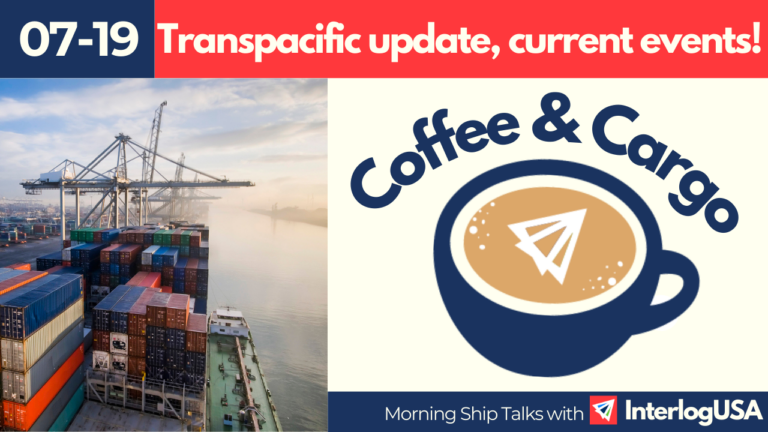
The following is an archived collection of our weekly insights throughout the month of July. Those who had signed up to our Interlog Insights newsletter received each week’s update to their inbox on the original release date. If you like what you see below, please feel free to sign up yourself to get these updates right as they come!
This month's insights
- Ocean Carrier Alliances
- Importing Outlook
- Severe Weather
- Independence Day
Week 3 - Originally released July 19
Insight: FMC To Evaluate Gemini Alliance's Competitive Impacts, Delaying Rollout
The rollout of an upcoming global shipping alliance has been delayed as a U.S. federal agency requests additional information regarding the cooperative agreement, originally planned to start in early 2025.
FMC to evaluate Gemini’s impact on competition
In May, ocean carriers Maersk and Hapag-Lloyd filed their Gemini Cooperation Agreement, a pact between the two where they would share vessels across international trade lanes, with the Federal Maritime Commission (FMC). However, the agency did not give the green light to these carriers, at least not yet. The FMC is demanding more information as it seeks to determine the competitive impacts that the envisioned shipping alliance will have on the industry.
Relevant Content: Interlog Insights – March 2024 (full coverage on Gemini Alliance’s formation)
In a press release published on July 12, the FMC wrote: “The commission has determined that the Gemini Cooperation agreement as submitted lacks sufficient detail to allow for a complete analysis of its potential competitive impacts.”
The agency went on to add: “Re-consideration of the agreement will not commence until the commission has received a fully compliant response to its inquiry.”
Denmark-based Maersk and Germany-based Hapag-Lloyd planned on the agreement to commence July 15 and take operational effect in February 2025. However, the FMC’s decision to investigate Gemini pushes back the timeline of the two carriers.
Previewing the future of alliances: Gemini Cooperation, independent MSC
The Gemini Cooperation marks a new chapter in the evolving landscape of international shipping networks. Maersk, the world’s second-largest carrier, mutually agreed with carrier MSC to terminate their fabled 2M Alliance in January 2025, ten years after its 2015 conception.
Meanwhile, Gemini’s other half, Hapag-Lloyd will leave THE Alliance at the same time. This will leave THE Alliance with three remaining members: Japan-based Ocean Network Express; Taiwan-based Yang Ming; and, South Korea-based HMM.
Without 2M, MSC, the world’s largest carrier by a comfortable margin, is largely speculated to not join or create a shipping alliance. Rather, it will likely sail on its network as it possesses over 5.7 million TEU capacity, a marvelous sum that is still growing from an outstanding orderbook of newbuild vessels.
In comparison, once enacted, Gemini Cooperation is forecasted to offer a combined capacity of six million TEU. Many stakeholders have called the future agreement too ambitious as the carriers vow unprecedented levels of service reliability and coverage. Gemini is centered on hub-and-spoke, an operational model widely used in the air freight sector.
Watch July’s webinar for the latest on the transpacific shipping market and relevant current events!
Insight: Indiana Planning a New Ocean Container Terminal
The Ports of Indiana’s ocean container terminal plan was recently approved by the U.S. Customs and Border Protection (CBP), Transport Topics reports. While still in the early stages, it’s apparent the Ports of Indiana will need to cover a few bases before they are able to start shipping containers through the Ports Harbor.
Ports of Indiana CEO Jody Peacock shared more details saying, they will engage in securing customers and partners to facilitate regular container service between the Greater Chicago metropolitan area and several international ports. The objective is to finalize all planning, financing, construction, and procurement activities by next year, enabling the commencement of initial shipments by 2026.
CBP’s approval affirms the necessity for the port to have a staffed CBP container cargo examination facility at the Burns Harbor port. The Ports of Indiana will also undertake the infrastructure construction, including a CBP office, equipment, furnishings, supplies, large-scale non-inspection equipment, radiation portal monitors, and security features as per CBP’s guidelines. Construction and installation of these are slated for this upcoming year.
The Ports of Indiana-Burns Harbor is located mere minutes from interstates 94, 80, 90, and 65 and already handles significant cargo volumes annually, largely relying on hundreds of thousands of trucks. Additionally, the port manages approximately 3.5 million tons of cargo each year, spanning bulk, breakbulk, and project cargo.
Week 2 - Originally released July 12
Insight: An Eventful Week of Extreme Weather
From a hurricane slamming the coast of Texas to maelstroms churning off the shores of southern Africa, this week has pitted supply chains against Mother Nature. Spoiler alert: Mother Nature always triumphs.
Texas ports reopened following Beryl
Early Monday, Hurricane Beryl breached the Texas coastline. The Category 1 storm wiped out power to nearly three million homes and businesses, while dumping heavy rain over a large swathe of the state, including the Houston area.
In the days leading up and following Beryl’s impact, Texas’ seaports, including Galveston, Freeport, and Houston, closed their facilities. However, as of Wednesday (July 10), said ports made the following announcements:
• Port of Houston: Via the port authority’s website, Port Houston provided notice on Wednesday morning that all terminals are “up and running”. Additionally, the port’s two container terminals will have extended gate hours through Saturday, July 13.
• Port of Galveston: Port officials announced cruise and cargo operations resumed Wednesday. The update added that the port’s infrastructure experienced little damage or impacts from power outages. As of Wednesday, the port placed temporarily draft restrictions (30 feet) on vessels and only permitting daylight transits.
• Port of Freeport: In a notice released Wednesday afternoon, port officials announced Freeport’s channels reopened to commercial ship traffic, however, have implemented a draft restriction of 36 feet on vessels. The port is also only permitting daylight transits.
Severe storm conditions off African coast ward off ship traffic, could spell delays
Throughout the week, inclement weather conditions—including high winds and waves towering over 30 feet—ran amok in the waters off the coast of southern Africa and around the Cape of Good Hope. The situation has forced commercial vessels to hold off from continuing their transits below the continent as they seek shelter to ride out the intense conditions. This includes some ships turning around and idling near ports along Africa’s eastern and western coasts.
The initial summoning of high winds and towering waves came as a cyclonic system blanketed the region on Sunday. Forecasters anticipate that these rough conditions could persist into the weekend, likely prolonging the halt in marine traffic below Africa.
In conventional times, the weather-related snafu would bear little to no impact on international trade as the routing around southern Africa is typically impractical for most shipping lanes. But, as all stakeholders are well aware, it is not a conventional time in international trade.
Throughout all of 2024, most sectors of commercial shipping have detoured around southern Africa amid ongoing geopolitical tensions in the Red Sea and Gulf of Aden. Since most trade routes are drawn to transit these waterways (via the Suez Canal), their indefinite omission as utilities has led to an unfathomable spike in vessel traffic around southern Africa.
The lengthier voyage already adds ten to 15 days in transit time from Asia origins to U.S. destinations, but by adding treacherous weather conditions to the mix, a fair deal of inbound volume would be delayed in the coming weeks if ships remain forced to batten down their hatches and wait.
Developing a contingency plan
Some things, especially weather, exist outside of everyone’s control. However, this should not be used as an excuse to not prepare for emergency or unexpected events that impact supply chains.
Relevant Content: FreightFM – Episode 2: Being Prepared and Proactive When Dealing with Emergency or Unexpected Events
Insight: U.S. Retail Group Upgrades Import Forecast for Sixth Consecutive Month
Earlier this week, the National Retail Federation (NRF) reiterated their expectation of continued import growth, marking the sixth consecutive month of upward revisions to their import forecasts.
Per the NRF’s Global Port Tracker, a monthly source of data and forecasts for major U.S. ports, July imports are projected to increase by 15.5 percent year-over-year. This forecast is up from their previous prediction last month where they suggested July imports would see a 9.5 percent year-over-year increase.
They also expect retail sales (minus automobile dealers, gasoline stations and restaurants) for this year to see a 2.5-3.5 percent increase from last year.
Cargo volumes are on the rise despite supply chain challenges such as tightening vessel space and increasing rates.
With schools reopening in a couple months, after their summer break is finished, consumer spending on back-to-school items is expected to rise. Retailers are prepared with ample stock to meet demand for both the upcoming back-to-school season and the approaching holiday season.
As August approaches, traditionally the peak shipping season leading up to Golden Week in parts of Asia, importers are advised to plan ahead, anticipate potential surcharges and fees, and explore alternative shipping option
Check out our other content!
Pay a visit to our website for a closer look at other InterlogUSA content, including recordings of past webinars, podcasts, and blogs. Follow InterlogUSA LinkedIn and Facebook pages for even more updates and content!
Week 1 - Originally released July 5 (Holiday Edition!)
Insight: U.S. Independence Day - A Business Opportunity for China Exports
Ironically, the banners of red, white, and blue that American citizens wave are likely not made on the soil of the country in which they symbolize. The same can be said for the aggressive flurries of fireworks that amateur pyrotechnics launch in their backyards. The Fourth of July is truly a special day, a holiday which recognizes America’s birth and how far the nation has come from its revolutionary beginnings, but as far as the need to satisfy American demand for holiday-related accoutrements – that service falls mostly on China.
Government trade statistics in 2016, the most recent data available, revealed that the value of fireworks imported to the U.S. was $308.8 million. Of that amount, $296.2 million of the commodity’s value was brought over from China.
Additionally, trade data from the same year, tallied the total value of American flag imports at $5.4 million. $5.3 million – nearly the entire sum – came from China.
The data translates into a perennial business opportunity for Chinese exports. While fireworks may not be a surprising revelation (after all, China invented fireworks), the dependence of imports to satiate U.S. demand for American flags on Independence Day can be a strange nugget of information.
Catching whiff of this fun fact, in November 2023, the All-American Flag Act unanimously passed in the Senate. The legislation, introduced by U.S. Senator Sherrod Brown of Ohio, proposes requiring the federal government to buy only flags completely produced and manufactured in the U.S. While the bill does not require, nor necessarily advocate, for U.S. citizens to do the same, the act does send a message that America’s affinity for importing should not extend to the federal government’s display of the country’s unassailable symbol – the American flag.
That said, just because an American flag was produced abroad in China, it should not dampen the spirit of U.S. Independence Day. In fact, waving a flag made overseas is just as American as waving one made in America. The U.S. is the world’s leading importer, a global buyer, which has forged trade relations in all nooks and crannies of the world. Surely, the Chinese-made American flag is a part of the Americana, just like Chinese-made fireworks.
Have a question about international shipping and logistics? Chat with Johnny Cargo, InterlogUSA’s AI Chat Bot!
Click on the image of Johnny to start a conversation today.
Insight: July 4 Fun Facts to Tell Friends and Family!
• What was the value of total fireworks imported in the U.S. last year?
Answer: About $396 million – per U.S. Census data
• How many consumers plan to observe July Fourth this year?
Answer: About 87 percent – per NRF data
• What does the average consumer intend to spend on food during this holiday?
Answer: $90.42 – per NRF data
• Which state became the first state to make July Fourth an official state holiday?
Answer: Massachusetts (in 1781)
• When did July Fourth become a federal holiday?
Answer: in 1870


